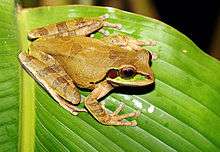New Granada cross-banded tree frog
The New Granada cross-banded tree frog (Smilisca phaeota, also known as the masked tree frog) is a species of frog in the family Hylidae found in Colombia, Costa Rica, Ecuador, Honduras, Nicaragua, and Panama. Its natural habitats are subtropical or tropical dry forest, subtropical or tropical moist lowland forest, rivers, freshwater marshes, intermittent freshwater marshes, plantations, rural gardens, urban areas, heavily degraded former forests, ponds, and canals and ditches.
| New Granada cross-banded tree frog | |
|---|---|
| Scientific classification | |
| Kingdom: | Animalia |
| Phylum: | Chordata |
| Class: | Amphibia |
| Order: | Anura |
| Family: | Hylidae |
| Genus: | Smilisca |
| Species: | S. phaeota |
| Binomial name | |
| Smilisca phaeota (Cope, 1862) | |
Their nickname of masked tree frog comes from the black or dark colored markings that start at their nose and go back along the face toward their ear, covering their eye.
Because it goes across their eye, it can help with camouflage, as many predators find prey by their open eyes.
Males are smaller than females: this species shows sexual dimorphism. The frog's upper surface has a usual tan colour throughout the day, but this can change to green during the night. It is found widely dispersed in Costa Rica except the driest areas of the Nicoya Peninsula, and found in altitudes up to 1100m. The frog is tolerant to changing habitat, but prefers edges of forest, ditches beside roads and secondary rainforest.[1]

References
- The Wildlife of Costa Rica; Fiona A.Reid
- Solís, F., Ibáñez, R., Chaves, G., Wilson, L.D., Morales, M. & Lynch, J. 2004. Smilisca phaeota. 2006 IUCN Red List of Threatened Species. Downloaded on 22 July 2007.
![]()
